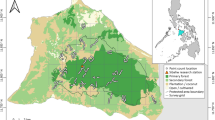Abstract
Urbanization is rapidly enveloping isolated remnants of Sonoran Desert habitat in southern Arizona. Understanding the means by which herpetofauna can persist in these habitats in the face of multiple impacts is vital to conservation efforts to retain intact biotic communities, especially those with a high diversity of reptile species. We surveyed ten preserves in the Phoenix Metropolitan region for Desert (Phrynosoma platyrhinos) and Regal (Phrynosoma solare) horned lizards, members of an iconic group of lizards of the Southwest. At least one horned lizard species is found in preserves across the range in size, age and habitat axes we assessed, provided that their primary prey, seed-harvester ants (Pogonomyrmex rugosus) are present. Horned lizards are apparently absent from one large preserve where they were once present, perhaps as a result of a decline in seed-harvester ants, but they may have been absent from other preserves due to the lack of appropriate habitat for their prey rather than due to direct anthropogenic impacts.



Similar content being viewed by others
References
Amo L, Lopez P, Martin J (2007a) Natural oak forest vs. ancient pine plantations: lizard microhabitat use may explain the effects of ancient reforestations on distribution and conservation of Iberian lizards. Biodivers Conserv 16:3409–3422
Amo L, Lopez P, Martin J (2007b) Habitat deterioration affects antipredatory behavior, body condition, and parasite load of female Psammodromus algirus lizards. Canadian J Zoo 85:743–751
Audsley BW, Bock CE, Jones ZF, Bock JH, Smith HM (2006) Lizard abundance in an exurban southwestern Savanna, and the possible importance of roadrunner predation. Amer Midlan Natur 155:395–401
Banville M, Bateman HL (2012) Urban and wildland herpetofauna communities and riparian microhabitats along the Salt River, Arizona. Urban Ecosyst 15:473–488
Barrows CW, Prestion KL, Rotenberry JT, Allen MF (2008) Using occurrence records to model historic distributions and estimate habitat losses for two psammophilic lizards. Biol Conserv 141:1885–1893
Brennan TC, Holycross AT (2005) Amphibians and reptiles of Maricopa County. Arizona Game and Fish Department, Phoenix, 68 pp
Davidson AD, Lightfoot DC, McIntyre JL (2008) Engineering rodents create key habitat for lizards. J Arid Environ 72:2142–2149
Esbah H, Cook EA, Ewan J (2009) Effects of increasing urbanization on the ecological integrity of open space preserves. Environ Manage 43:846–862
Fischer J, Lindenmayer DB, Barry S, Flowers E (2005) Lizard distribution patterns in the Turmut fragmentation “Natural Experiment” in south-eastern Australia. Biol Conserv 123:301–315
Fisher RN, Suarez AV, Case TJ (2002) Spatial patterns in the abundance of the coastal horned lizard. Cons Biol 16:205–215
French SS, Fokidis HB, Moore MC (2008) Variation in stress and innate immunity in the tree lizard (Urosaurus ornatus) across an urban–rural gradient. J Comp Phys B 178:997–1005
Garden JG, McAlpine CA, Possingham HP, Jones DN (2007) Habitat structure is more important than vegetation composition for local-level management of native terrestrial reptile and small mammal species living in urban remnants: a case study from Brisbane. Austral Ecol 32:669–685
Grant TJ, Doherty PF (2009) Potential mortality effects of off-highway vehicles on the flat-tailed horned lizard (Phrynosoma mcallii): a manipulative experiment. Environ Manag 43:508–513
Guillera-Arroita G, Ridout MS, Morgan BJT (2010) Design of occupancy studies with imperct detection. Methods in Ecol Evol 1:131–139
Hollander M, Wolfe DA (1973) Nonparametric statistical methods. Wiley, New York
Jennings MR (1987) Impact of the curio trade for San Diego horned lizards (Phrynosoma coronatum blainvillii) in the Los Angeles Basin, California: 1885–1930. J Herpetol 21:356–358
Johnson RA (1992) Soil texture as an influence on the distribution of the desert seed-harvester ants Pogonomyrmex rugosus and Messor pergandei. Oecologia 89:118–124
Jones TR, Babb RD, Hensley F, LiWanPo C, Sullivan BK (2011) Sonoran Desert snake communities at two sites: concordance and effect of increased road traffic. Herpet Conserv Biol 6:61–71
Kitchner DJ, Chapman A, Dell J, Muir BG (1980) Lizard assemblage and reserve size and structure in the western Australian wheatbelt—some implications for conservation. Biol Conserv 17:25–62
Koenig J, Shine R, Shea G (2001) The ecology of an Australian Reptile icon: how do Blue-tongued Lizards (Tiliqua scincoides) survive in suburbia? Wildlife Res 28:215–227
Lettink M, Norbury G, Cree A, Seddon PJ, Duncan RP, Schwarz CJ (2010) Removal of introduced predators, but not artificial refuge supplementation, increases skink survival in coastal duneland. Biol Conserv 143:72–77
Litteral J, Wu J (2012) Urban landscape matrix affects avian diversity in remnant vegetation fragments: evidence from the Phoenix metropolitan region, USA. Urban Ecosyst 15:939–959
MacNally R, Brown GW (2001) Reptiles and habitat fragmentation in the box-ironbark forests of central Victoria, Australia: predictions, compositional change and faunal nestedness. Oecologia 128:116–125
Manly BFJ (1986) Multivariate statistical methods: a primer, 2nd edn. Chapman & Hall Press, London
Martin J, Lopez P (2002) The effect of Mediterranean dehesa management on lizard distribution and conservation. Biol Conserv 108:213–219
Newbold TAS, MacMahon JA (2009) Spatial and seasonal dietary patterns of the desert horned lizard (Phrynosoma platyrhinos): harvester ant specialist or generalist ant feeder? Can J Zool 87:112–123
Pellet J, Schmidt BR (2005) Monitoring distributions using call surveys: estimating site occupancy, detection probabilities and inferring absence. Biol Conserv 123:27–35
Rhodes JR, Lunney D, Moon C, Matthews A, McAlpine CA (2011) The consequences of using indirect signs that decay to determine species’ occupancy. Ecoggraphy 34:141–150
Rorabaugh JC, Palermo CL, Dunn SC (1987) Distribution and relative abundance of the flat-tailed horned lizard (Phrynosoma mcallii) in Arizona. Southwestern Natur 32(1):103–109
Saenger A, Saenger E, Saenger T, Saenger W (2011) A natural history of Texas horned lizards (Phrynosoma cornutum) in a rural subdivision. Bull Chicago Herpet Soc 46(8):93–105
Santos T, Diaz JA, Perez-Tris J, Carbonell R, Telleria JL (2008) Habitat quality predicts the distribution of a lizard in fragmented woodlands better than habitat fragmentation. Animal Conserv 11:46–56
Sarre S, Smith GT, Meyers JA (1995) Persistence of two species of gecko (Oedura reticulata and Gehyra variegata) in remnant habitat. Biol Conserv 71:25–33
Sherbrooke WC (1981) Horned lizards: unique reptiles of western North America. Southwest Parks and Monuments Association. Globe, Arizona
Sherbrooke WC (2003) Introduction to horned lizards of North America. Univ California Press, Berkeley
Sullivan BK (2000) Long-term shifts in snake populations: a California site revisited. Biol Conserv 94:321–325
Sullivan BK, Flowers M (1998) Large iguanid lizards of urban mountain preserves in northern Phoenix, Arizona. Herpet Natur Hist 6(1):13–22
Sullivan BK, Fernandez PJ (1999) Breeding activity, estimated age-structure, and growth in Sonoran Desert anurans. Herpetologica 55:334–343
Sullivan BK, Sullivan KO (2008) Common chuckwalla (Sauromalus ater) populations in the Phoenix Metropolitan area: stability in urban preserves. Herpet Conserv Biol 3:149–154
Sullivan BK, Williams RE (2010) Common chuckwallas (Sauromalus ater) in urban preserves: do food plants or crevice retreats influence abundance? Herpet Conserv Biol 5:102–110
Trubl P, Gburek T, Miles L, Johnson JC (2011) Black widow spiders in an urban desert: population variation in an arthropod pest across metropolitan Phoenix, AZ. Urban Ecosyst 15:599–609
Zar JH (1999) Biostatistical analysis, 4th edn. Prentice Hall, Upper Saddle River
Acknowledgments
This work was supported in part by Heritage Fund Grants from the Arizona Game and Fish Department. Erik Gergus, Paul Hamiltion, Matthew Kwiatkowski, and Elizabeth and Justin Sullivan assisted with some field observations. We thank M. Kwiatkowski for comments on a previous draft of the manuscript. Mike Sredl, Oliver Hyman, and especially Benedikt Schmidt provided considerable assistance with Presence. Bob Johnson was exceptionally helpful with identification and natural history information on seed harvester ants. All research was permitted under Arizona Game and Fish Department Scientific Collecting Permits (1995–2012) and ASU IACUC approval.
Author information
Authors and Affiliations
Corresponding author
Rights and permissions
About this article
Cite this article
Sullivan, B.K., Sullivan, K.O., Vardukyan, D. et al. Persistence of Horned Lizards (Phrynosoma spp.) in urban preserves of Central Arizona. Urban Ecosyst 17, 707–717 (2014). https://doi.org/10.1007/s11252-014-0353-4
Published:
Issue Date:
DOI: https://doi.org/10.1007/s11252-014-0353-4




